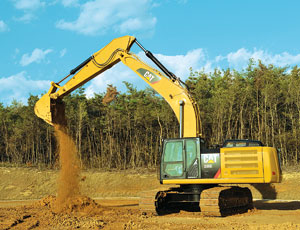Prices for Caterpillar construction equipment will rise by about 12% over the next four years as the company rolls out new and revised models that meet the next level of worldwide clean-air standards.

About a third of the overall price increase will start next year, said Cat officials at the company’s Peoria, Ill., headquarters on Feb. 11. In 2011, the U.S. Environmental Protection Agency’s Tier 4 Interim and European Union Stage IIIB standards take effect. The rest of the increase will phase in over the following three years, leading up to Jan. 1, 2014, when Tier 4 Final/Stage IV rules are enforced.
The price increases will help Caterpillar recoup the massive research-and-development cost of bringing to market diesel-powered products that run more cleanly and productively than their predecessors. In 2009 alone, the equipment maker spent $6 million every working day—over the last six years, it has spent $7.5 billion—largely in these efforts.
The new pricing will be spread proportionally across more than 300 affected products, Cat says. The incremental pricing structure is designed to keep the relative value of different models about the same as before the Tier 4 regulations. About one-third of the price increase, or 4%, will take effect on Jan. 1, 2011.
Package Deal
Caterpillar’s strategy for meeting Tier 4 hinges on what it calls its Clean Emissions Module (CEM), an after-treatment package that can be installed on new or existing engines, providing economies of scale. A range of CEMs will match up with engines of different power outputs. The units will offer on-the-fly regeneration, which periodically burns particulate into ash without needing to idle the machine.
In Peoria, Cat displayed a new Tier 4 model 336E excavator fitted with a CEM. In keeping with Cat’s just-in-time production, the excavator rode into the demonstration yard five minutes before the demo. It made the two-hour stopover in Peoria while on its way from a California port to a construction project at which Omaha, Neb.-based contractor Kiewit Corp. will conduct on-the-job testing.
Phased in from 2011 to 2013, Tier 4 Interim is the next step of EPA’s ongoing program to cut exhaust emissions from diesel-powered non-road equipment like skid-steer loaders, excavators and bulldozers. It requires diesel engines to put out 90% less particulate exhaust and 50% less nitrogen oxide (NOx) gas than the current Tier 3 requirements.
Tier 4 Final regulations, which kick in on Jan. 1, 2014, will cut the allowable NOx exhaust by another 50%. They will have no additional effect on particulate exhaust, which virtually will be eliminated by Tier 4 Interim standards. Selective-catalytic reduction, or SCR, “is among the technologies” Cat says it is considering for its Tier 4 Final machines.
Lowering emissions is just one part of Cat’s strategy. “Our ultimate goal is to exceed [customer] expectations,” said Rod Beeler, vice president of marketing and product support. Despite the price increase, Cat expects its Tier 4 machines to cost less to own and operate over their lifetime than current Tier 3-compliant machines because of better fuel economy and higher productivity. For example, Cat expects its 9.3-liter Tier 4 Interim engine to provide 5% better fuel economy than the outgoing Tier 3 engine.
The new powerplants will have service intervals similar to that of existing engines, Cat execs say, and although they may need a different oil, they will use an industry-standard grade. The new engines also will require diesel fuel that contains 15 parts per million or less of sulfur and, to meet European standards, less than 10 ppm of sulfur. By 2014, off-road engines will be in step with the latest tailpipe regulations for diesel cars and trucks, which finished phasing in this year.
For owners that want to retrofit an existing machine with Tier 4 controls, Cat dealers will offer four options: after-treatment, engine upgrades, repowering or buying a new machine. Trained advisers will help customers evaluate which options make the best sense, says Beeler.











Post a comment to this article
Report Abusive Comment